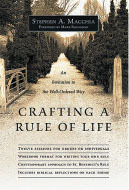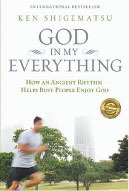Listen to our podcast
Ken Shigematsu is familiar with stress. After leaving a Fortune 500 company in Tokyo, he became pastor of Tenth Church in downtown Vancouver. "I don’t suffer from an absence of crisis or stress," he says, yet his wife calls him the happiest pastor she knows. The reason is simple, according to Shigematsu – he uses a rule of life. "It’s what connects me to friendship with Jesus," he says. "It allows me to fulfill my vocation out of my calling rather than out of burden."
The idea of a rule of life began with monks in the 3rd to 5th centuries who withdrew from society and created guidelines to help people learn Christlikeness. Benedict (AD 480–547) created the most widely used set of monastic rules, which is still used today.
More recently, the idea has been gaining traction among Evangelicals. Dallas Willard said a rule of life was a "curriculum in Christlikeness." John Ortberg calls it a "game plan for morphing." Peter Scazzero, author of Emotionally Healthy Spirituality, recommends the practice, as does Stephen Macchia in his book Crafting a Rule of Life.
"A rule of life allows us to clarify our deepest values, our most important relationships, our most authentic hopes and dreams, our most meaningful work, our highest priorities," writes Macchia. "It allows us to live with intention and purpose in the present moment."
In his book God in My Everything, Shigematsu defines the term. "A rule of life is simply a rhythm of practices that empowers us to live well and grow more like Jesus by helping us experience God in everything."
The word rule isn’t about an abstract law. Rule comes from the Greek word for trellis, those wooden structures we use to give our plants room to stretch. Rules, like trellises, are designed to support and guide growth.
"The purpose of the rule, in this sense, is not to be harsh or confining. It is to cultivate fruit. It serves as a pattern for life that enables us to experience the presence of Jesus in each moment of our lives, empowering us to become people who embody His love to others," says Shigematsu.
A rule of life is not just another thing to do. It should help our lives feel simpler and less cluttered.
Developing a rule of life doesn’t have to be complicated. "My most important counsel is to start small and simply," advises Shigematsu. Start with one practice at a time, he advises, beginning with a practice that connects you to God. When ready, he says, add a practice that brings refreshment, followed by a practice that connects you to others through relationship and service.
"A sustainable rule of life will be built slowly, tested, and regularly revised," he writes. It must honour our personality, design and stage of life. "We don’t exist for the rule," he says. "The rule exists for us."
While Shigematsu traces the idea of a rule of life to the monastery, he sees evidence that at least one biblical character also used a similar practice. "Daniel is the first person in the Bible we know of who consciously lived by a rule of life," he writes. Daniel lived by a rule that guided his actions, even when facing pressure from a hostile culture.
Shigematsu’s own rule is simple, and includes items like these:
- Take a 24-hour Sabbath once a week.
- Begin each day with Scripture and prayer.
- Aim to be home by 5:15 p.m. each day, and to be home at least four evenings a week.
- Go on a date with my wife once every two or three weeks.
- Host people from different backgrounds in our home about once a month.
The payoff has been significant. This past December, Shigematsu and his wife Sakiko faced an especially busy month with ministry activities, family celebrations and a translation project. Despite the busyness, they felt less stress. "For a lot of people who feel busy and are trying to keep their head above water, a rule of life keeps them centred," he says.
Brad Somers, pastor of PAXnorth in Halifax, found that writing a rule of life seemed like a daunting challenge at first. "I didn’t want to just write out a maxim or a platitude so I could check the box as ‘answered,’" he says. "I actually wanted to be able to both capture what the core value of my life is and build a reasonable ‘rule’ that would have a propelling effect in habits of growth."
The effort was worth it. "I printed off the original and put it in a place where I will see it almost daily. Almost two months later, I am thankful to say that it has functioned as a helpful reminder. It has propelled, encouraged, and reminded me of the core desire out of which I feel compelled to live life. This ‘rule of life’ has functioned for me as the first step, the one that often compels me further into the habits of growth for the day."
Shigematsu says he frequently talks to others who have created their own rules of life and what a difference it has made in their lives.
"My happiness also largely flows from my rule of life, this trellis that supports my friendship with God," Shigematsu writes. "I used to feel like I was always treading water and sometimes feared I’d drown under a tidal wave of work and responsibility. Thanks to my rule, I now enjoy the life-imparting gift of the Sabbath and a simpler, less cluttered life. I thus live from a place of greater rest and peace than I would otherwise."
How to build a rule of life
A rule of life is an ancient practice, but it’s one that can help us cultivate peace and a friendship with Jesus among the pressures of our lives. It can help us, as Shigematsu says, to experience God in our everything.
1. List your categories
Your rule of life should cover the most important areas of your life. In his book God in My Everything, Shigematsu lists categories that apply to everyone:
- Root practices — Sabbath, prayer and God’s Word
- Relating — spiritual friendships, sexuality and family life
- Restoring — care for the body, play and money
- Reaching out — work, justice and witness.
If this is your first time creating a rule of life, begin with one or two of the root practices (Sabbath, prayer and God’s Word), and build from there.
2. Think through what works for you
Some of us function best in the morning, while others come awake at night. Some thrive when they work alone, while others work best with others. Some like structure, while others prefer flexibility. Take a look at the categories you’ve chosen. Focus on what helps you be most aware of God’s presence and love, and what provides the greatest nourishment, refreshment and renewal.
3. Think through rhythms
Begin to think through your categories, and what works best for you in light of your life’s rhythms. Which practices will you pursue daily? Which ones will you pursue weekly? Which ones will you pursue monthly, quarterly or annually?
4. Simplify
Prune so that your rule of life is realistic. Emphasize the areas that are most strategic for you right now. Consider your existing commitments, energy level and stage of life.
5. Just get started
Creating a rule of life can be overwhelming at first. Get started with a first draft, experiment and refine it over time.
–DD
Helpful books
 The Rule of St. Benedict is available in many editions. Contemporary readers may appreciate The Rule of St. Benedict: A Contemporary Paraphrase by Jonathan Wilson-Hartgrove (Paraclete, 2012)
The Rule of St. Benedict is available in many editions. Contemporary readers may appreciate The Rule of St. Benedict: A Contemporary Paraphrase by Jonathan Wilson-Hartgrove (Paraclete, 2012)

Crafting a Rule of Life: An Invitation to the Well-Ordered Way by Stephen Macchia (InterVarsity Press, 2012)

God in My Everything: How an Ancient Rhythm Helps Busy People Enjoy God by Ken Shigematsu (Zondervan, 2013)
Darryl Dash is founding pastor of Liberty Grace Church in Toronto and founder of Gospel for Life Canada.